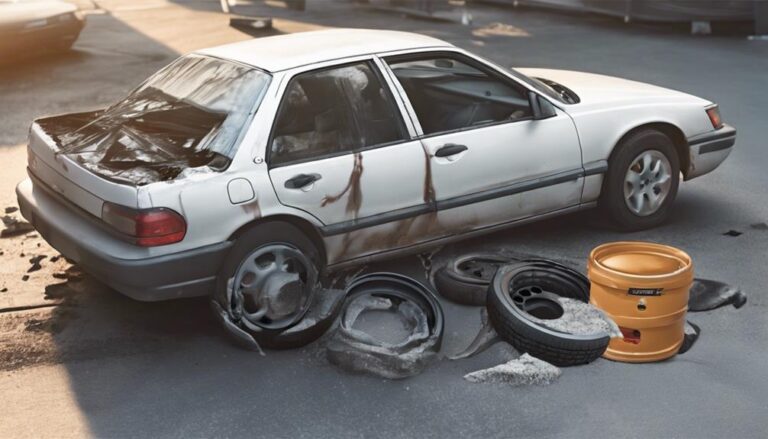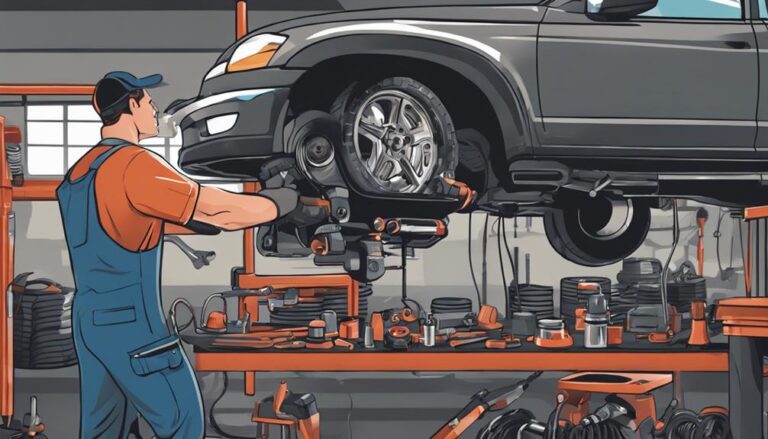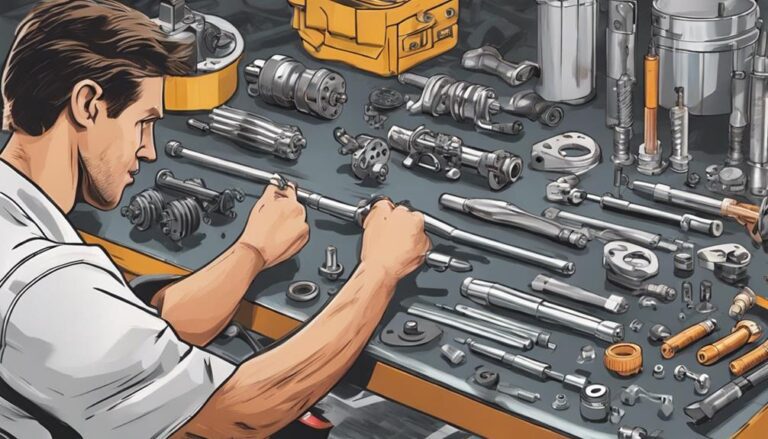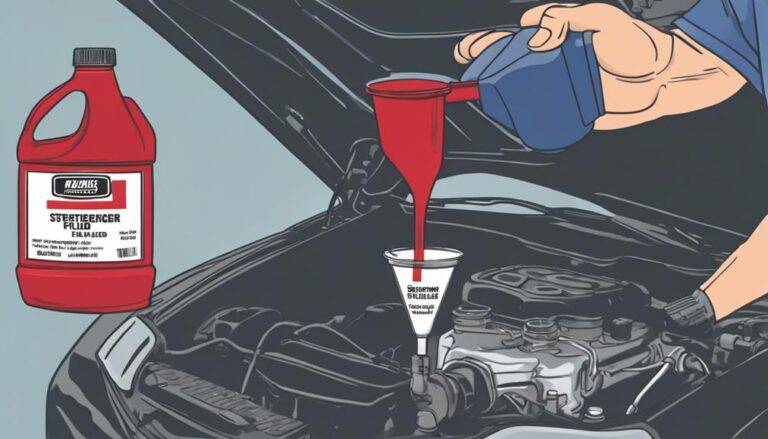Why Proper Wheel Alignment Is Crucial Post Suspension Repair
When it comes to post-suspension repair, did you know that a staggering 70% of vehicles experience misalignment issues? Proper wheel alignment is not just a mere formality; it is a critical step post-repair that can significantly impact your driving experience and safety on the road.
Without it, you may be unknowingly setting yourself up for a host of potential problems that could affect your vehicle's performance and longevity. So, why is wheel alignment post-suspension repair so crucial? The answer lies in the intricate balance of your vehicle's components and how they interact to ensure a smooth and safe ride.
Key Takeaways
- Proper alignment post-repair ensures optimal handling and steering control.
- Correct alignment prevents uneven tire wear, extending tire and suspension lifespan.
- Misalignment increases stress on the suspension, affecting safety and performance.
- Investing in alignment post-repair maximizes safety, efficiency, and overall driving experience.
Importance of Wheel Alignment After Suspension Repair
Ensuring proper wheel alignment following suspension repair is crucial for maintaining vehicle safety and performance. Alignment precision is key in optimizing handling improvement and steering control post-repair.
By aligning the wheels correctly, you can prevent uneven tire wear and extend the lifespan of suspension components. Misalignment after suspension repair can lead to increased stress on the suspension system, affecting both safety and performance.
Correct alignment not only enhances overall driving safety but also ensures the stability of the vehicle on the road. It's imperative to prioritize wheel alignment after suspension repair to maximize the longevity and performance of new suspension parts.
Neglecting this crucial step can compromise the effectiveness of the repair work done on the suspension system. Therefore, investing in proper alignment post-repair is a proactive measure that directly impacts the safety and efficiency of your vehicle.
Benefits of Proper Wheel Alignment
Proper wheel alignment post suspension repair offers several key benefits that directly impact your vehicle's performance and safety.
- Alignment advantages: Correct alignment ensures even tire wear, extending the lifespan of your tires and reducing maintenance costs over time.
- Tire longevity: By maintaining proper wheel alignment, you improve fuel efficiency, reduce rolling resistance, and decrease the engine workload, ultimately saving on gas expenses.
- Improved handling and safety: Proper alignment enhances control, stability, and traction on the road, leading to better handling and increased safety for you as the driver.
Ensuring your vehicle's wheels are correctly aligned not only promotes optimal tire longevity but also contributes to a smoother driving experience and enhanced safety on the road. By preventing premature wear on suspension components, you can avoid costly repairs and optimize the longevity of your suspension system. Prioritizing proper wheel alignment post suspension repair is key to maximizing your vehicle's performance and safety.
Impact of Suspension Repair on Alignment

Suspension repairs can significantly impact the alignment of your vehicle's wheels, potentially leading to misalignment issues that affect driving performance and safety. Changes in suspension components can alter the camber, toe, and caster angles, affecting alignment accuracy.
Misaligned suspension after repairs can result in uneven tire wear and compromised vehicle handling. To ensure optimal handling improvement, it's crucial to check and adjust the alignment post-suspension repair.
Proper wheel alignment is essential to prevent premature tire wear and maintain vehicle stability. Neglecting alignment checks can lead to poor handling, reduced fuel efficiency, and safety hazards.
Signs You Need a Post-Repair Alignment
If you notice steering wheel vibrations, vehicle pulling to one side, or handling changes after suspension repairs, it may indicate the need for a post-repair alignment. Ensuring proper alignment is crucial for your safety and the handling of your vehicle.
Here are the signs that suggest the necessity of a post-repair alignment:
- Uneven Tire Wear: Misalignment can lead to uneven tire wear, reducing the lifespan of your tires and requiring premature replacements.
- Suspension Stress: Improper alignment post-repair can stress suspension components, affecting their longevity and performance over time.
- Safety Concerns: A post-repair alignment is essential to maintain optimal suspension functionality, ensuring your safety on the road and preventing potential hazards.
Ensuring Longevity Through Wheel Alignment

To ensure the longevity of your vehicle's components, precise wheel alignment following suspension repairs is crucial. Alignment maintenance post suspension repair plays a vital role in extending tire longevity. By preventing uneven tire wear, proper alignment ensures that your tires last longer, saving you money in the long run.
Moreover, aligning your wheels after suspension work reduces stress on various components, preserving the lifespan of suspension parts. This not only enhances the durability of your vehicle but also contributes to a smoother driving experience.
Proper wheel alignment post suspension repair also benefits the overall stability of your vehicle. It improves handling and promotes optimal traction by ensuring even weight distribution across all tires. This, in turn, enhances safety on the road by reducing the risk of skidding or losing control.
Neglecting alignment after suspension repairs can lead to premature suspension wear, emphasizing the necessity of this maintenance step for the longevity of your vehicle's crucial components.
Frequently Asked Questions
Do You Need Wheel Alignment After Suspension?
After suspension work, you definitely need a wheel alignment. Without it, you risk uneven tire wear and handling issues. Aligning your wheels post-repair ensures optimal performance and safety, preventing premature tire and suspension part deterioration.
Do I Need an Alignment After Replacing Suspension?
After replacing suspension parts, you need an alignment. It's crucial for checking tires and enhancing steering response. Misalignment can cause uneven tire wear and stress on new components. Ensure optimal handling and safety.
What Is the Reason Why Wheel Alignment Is Important?
Aligning your wheels is crucial for tire wear, handling performance, vehicle safety, and steering accuracy. Proper alignment ensures even tire wear, enhances handling, and promotes safe driving by optimizing steering accuracy and vehicle stability.
Can Bad Alignment Mess up Suspension?
Improper alignment can indeed mess up your suspension, causing premature wear and affecting handling. To prevent this, ensure regular alignment checks post-suspension maintenance. Proper alignment impacts tire wear and suspension longevity, maintaining your vehicle's performance.
Conclusion
Ensure your vehicle's performance is optimized by prioritizing proper wheel alignment after suspension repair.
Just like a finely-tuned instrument, your car's alignment ensures smooth and precise handling on the road.
Don't let misaligned wheels throw off the harmony of your vehicle's suspension system.
Keep your car driving like a well-oiled machine by getting a post-repair alignment to avoid unnecessary wear and tear.
Drive confidently knowing your wheels are aligned for maximum efficiency and safety.







